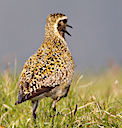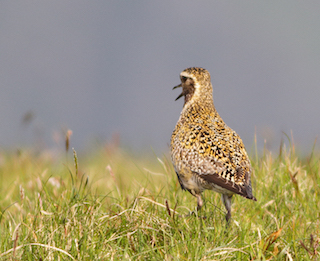 Golden Plovers hang out together in flocks on grasslands and marshy areas in the winter. Windmill Farm is one of the best places to see them on The Lizard.
Golden Plovers hang out together in flocks on grasslands and marshy areas in the winter. Windmill Farm is one of the best places to see them on The Lizard.
Photo: Amanda Scott
Scientific name: Pluvialis apricaria
Other common names: European Golden Plover
Conservation status: UK Birds of Conservation Concern, Amber (because the UK hosts an important non-breeding winter population)
 The Golden Plover gets its name from its striking gold plumage, strongly contrasting in the summer with its black belly and face: outside the breeding season the black plumage changes to buff and white. In the summer, Golden Plovers are found in their upland breeding areas, but in the winter large flocks form on lower lying grassland, estuaries and coastal marshy areas, and can be seen flying in close formation, often in mixed flocks with Lapwing. The species is resident in the UK, but numbers are swollen in the winter by visitors from further north.
The Golden Plover gets its name from its striking gold plumage, strongly contrasting in the summer with its black belly and face: outside the breeding season the black plumage changes to buff and white. In the summer, Golden Plovers are found in their upland breeding areas, but in the winter large flocks form on lower lying grassland, estuaries and coastal marshy areas, and can be seen flying in close formation, often in mixed flocks with Lapwing. The species is resident in the UK, but numbers are swollen in the winter by visitors from further north.
Globally, Golden Plovers are distributed from northern Europe to the Mediterranean and Persian Gulf. They feed on invertebrates, including earthworms, caterpillars and beetles, mainly at night. One brood is produced per year, laying about four eggs that are incubated by the female for a month. The hatchlings take 25 to 33 days to fledge. Nest predation by crows, gulls, foxes and other animals can be a problem. However, the main threat to this and similar species is created by changes in land use, such as land drainage and agricultural intensification. Conservation effort therefore focuses on habitat management and promoting farming practices that support birds associated with farmland.
Did you know…?
…Sunshine after rain? The genus name Pluvialis comes from the Latin verb for ‘to rain’, while the species name apricaria means ‘sun-kissed’.
…Bird records: Sir Hugh Beaver established the Guinness Book of Records in 1955 following a shooting party in Ireland when there was much discussion about the speed at which Golden Plovers flew (see BTO reference below).
More information and references:
Gooders, J. and Harris, A., 1986. Field Guide to the Birds of Britain and Ireland. Kingfisher Books, London.
Published: December 2013
Author: Amanda Scott
Photos: Amanda Scott
